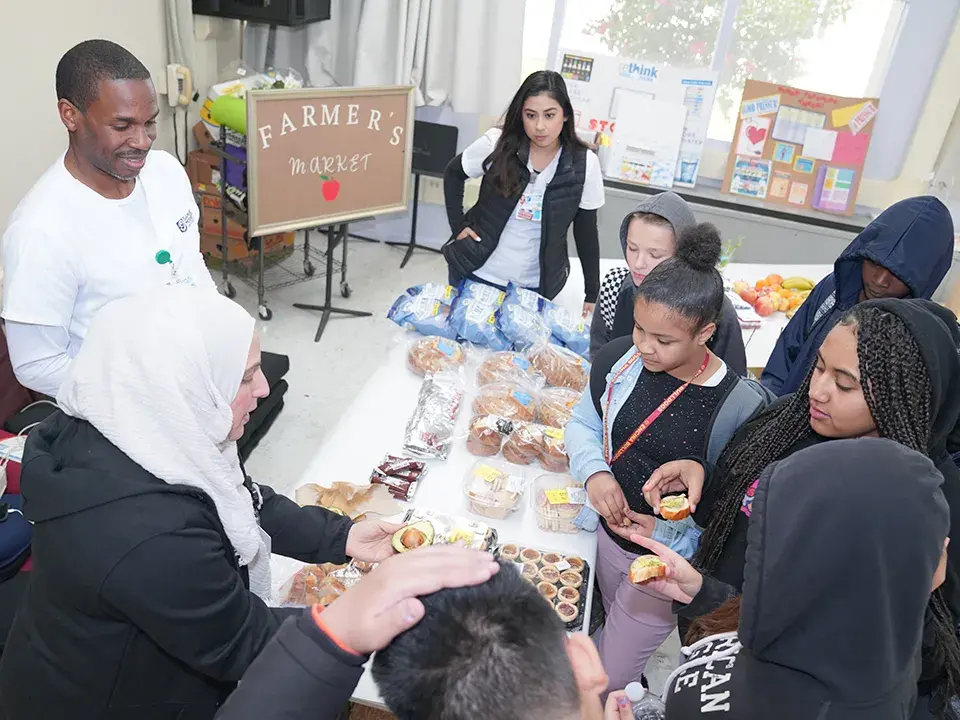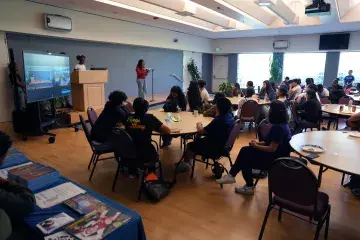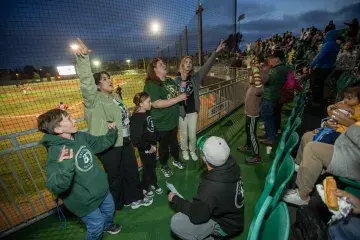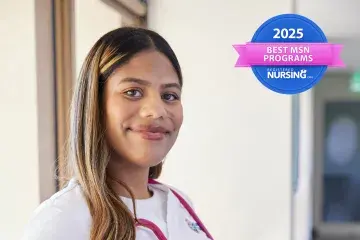SMU’s Nurses to Schools Corps Promotes Health by Tackling Trauma

Samuel Merritt University (SMU) nursing students spread apples, bananas, seeded bread, and other healthy foods across two long tables. Soon a group of middle school students in hoodies streamed into a wellness room that SMU created by adding fresh paint, a colorful wall hanging, and yoga chairs to an old computer lab at a Sacramento public school.
While the middle schoolers were hesitant at first when offered avocado toast, one by one they tried it and seemed surprised that they liked it. One boy seemed skeptical about Muscle Milk© until he learned that the high-protein drink wasn’t milk at all. A girl selected a bouquet of flowers and said she was going to place it on her grandmother’s grave.
The idea of a “farmers’ market” was new for many of the young students, but soon they got the hang of it and put food in their backpacks to take home. They also were encouraged to read the “cool fact” cards at each station that explained the nutritional benefits of each food type.
“Nutrition here is tricky because you run into cultural differences,” said Adriana Scholten, a second-year student in SMU’s Entry Level Master of Science in Nursing — Case Management (ELMNS) program.
The activity took place in early February at the culturally and ethnically diverse Encina Preparatory School, where 97 percent of the 1,077 students in grades six through 12 qualify for free or reduced-priced lunches and most live in low-income neighborhoods that are several miles from the nearest supermarket.
Located in the community of Arden-Arcade, Encina lays at the crossroads of some of Sacramento’s most affluent and impoverished neighborhoods. While California is leading the nation in the growth of income inequality, U.S. Census Bureau data suggests that Arden-Arcade may have the largest economic disparity of any community in the state.
“There are reasons that perhaps our children have bad nutritional habits, not by choice but by circumstances,” said Encina Principal Richard Judge. “Many are on fast-food diets and some come from rural communities and no longer have access to the fruits and vegetables they were used to.”
Having the SMU nursing students on campus to provide health and wellness education to the Encina community is a first for the school, part of a larger effort to improve student outcomes by providing support services.
“Our kids long so much to have positive adult role models, people who look like them and are doing positive things,” Judge said of the diverse group of SMU students.
Tackling trauma
Traditionally, nursing students have worked in public health departments to fulfill their community health rotations, but those opportunities are dwindling. Last year, SMU began a unique partnership with Encina and another Sacramento middle school that places nursing students in the economically disadvantaged schools where they build relationships with students and staff.
So far, participants in the clinical placement have included students from the RN to BSN, Accelerated Bachelor of Science in Nursing, and ELMNS programs from SMU’s Sacramento campus.
The community collaboration introduces the nursing students to the public health issue of Adverse Childhood Experiences (ACEs) — abuse, neglect, transiency, food insecurity, homelessness, or exposure to crime and violence — that put young people at higher risk of developing chronic diseases when they are older.
“There are a lot of challenges in these children’s lives,” said Alice Vestergaard, EdD, a community health instructor, who initiated the “Nurses to Schools Corps” at SMU.
At the start of the rotation, SMU student Ghada Saloha said it was difficult for her to understand how working with school children connected to medicine. Now, she said, she recognizes the significant role that ACEs play in the lives of the Encina children.
“Once I realized that, I understood the importance of prevention and how what you go through in your childhood has effects on a biological level,” she said. “Prevention has everything to do with medicine. It’s the most important part.”
Sometimes listening is enough
In recent years, a growing number of immigrants have enrolled in Encina, ranging from Central Americans fleeing poverty and violence in their native countries to refugees from war-torn Afghanistan, Iraq, and Syria. As a result, 22 native languages are spoken on the campus including Spanish, Arabic Pashto, and Farsi. More than a third of Encina students are English language learners.
Despite the language barriers, the SMU students say they have found ways to connect with the middle and high schoolers, relying on peer translators, paying close attention to nonverbal gestures that reveal emotions, or engaging in activities like sports or art.
Saloha, who speaks Arabic, has been able to talk to some of the Encina students in their native language.
“They’re inquisitive and appreciative of everything we do no matter how little,” she said. “That’s been what’s so rewarding about this rotation.”
Many of the future nurses say they quickly overcame the negative stigmas associated with schools in low-income neighborhoods, such as bad behavior and poor attention, when they found the Encina students to be respectful and eager to learn.
“Anyone who has gone through so much trauma really appreciates the good in life,” said Saloha.
Applying new skills to nursing
By providing activities for students and staff that promote resiliency, the SMU students function more as social workers and educators than as school nurses. Their mental health training teaches them about ACEs and therapeutic communication, but they had to find new ways of talking to the children. One-on-one conversations, they found, are the most effective.
“They share things with you that shock you,” said Scholten. “Sometimes they joke about the adversity they’re facing when their friends are around.”
The SMU students are learning valuable lessons that they say are enhancing their development as nurses by learning the right questions to ask their patients.
David Santellan, who is studying to become a family nurse practitioner, said the rotation with the school children is a departure from his other internships in hospitals and clinics.
“The experience is letting me see through their eyes what they’re struggling with back home,” he said. “It gives me a better perspective of what they’re going through and how I can provide better care.”
Barry Roth, Encina’s community coordinator and an English teacher, said the children’s trauma and the high turnover rate among students whose families are often on the move can be stressful for the staff.
“To be a teacher here is vastly different than at most other schools,” said Roth.
Principal Judge, who is working to transform Encina from what was once a failing school into a success story, said the Nurses to Schools Corps is having an impact on both Encina and SMU. He said the collaboration is helping to fulfill his students’ needs and support his teachers, while also revealing to the future nurses how kids’ health is like the layers of an onion.
“It’s been a win-win for both of us,” he said.


